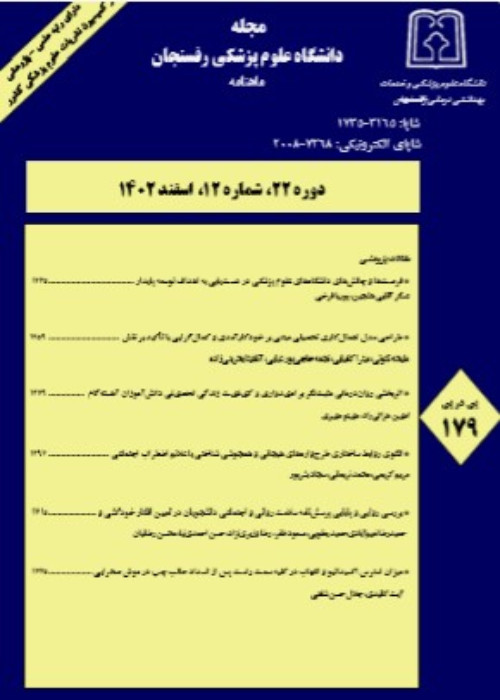Prevalence of Goiter and Urinary Iodine in 6-11 Years Old Students of Yazd in the Year 2002
Author(s):
Abstract:
Background
Iodine deficiency disorders (IDD) are among the most important epidemic disorders in the world and also in our country. The surveillance of IDD may be implemented to: assessing the prevalence of IDD, identifying the high risk areas for intervention and monitoring and evaluateing IDD control programmes, as salt iodized programme. The aim of this study was to determine the total goiter rate (TGR), urinary iodine in 6-11 years old students in Yazd city 10 years after iodized salt program. Materials And Methods
In this study, 1989 primary school students (1367 boys and 622 girls) aged 6-11 were selected by multistage “probability proportionate to size” cluster(PPS) sampling method in Yazd city. Thyroid examination and goiter classification were made according to WHO standard protocol by two trained physicians. Urine and household salt samples were collected from one-thirteenth of the total population (140 individuals). Urinary iodine was determined by digestion method. Salt iodine was determined by rapid test kit. Results
TGR of Yazd city was 40.2% (Girls 41% and boys 39.9%). Prevalence of goiter grade 1 and grade 2 were 38.7% (39.2% for girls and 38.5% for boys), and 1.5% (1.8% for girls and 1.4% for boys), respectively. The rate of goiter was not significant between the two sexes). Age specific TGR at 6-6.9,7-7.9, 8-8.9, 9-9.9 and 10-11 age groups were 39%, 37.7%, 42%, 40% and 42.1%, respectively. Age spesific goiter grade 1 in this age groups were 38.7%, 35.2%, 40.5%, 38.8% and 39.9%, respectively. Age spesific goiter grade 2 in this age groups were 0.3%, 2.3%, 1.5%, 1.3% and 2.2%, respectively. TGR in this age groups were not significant(p=0.3). The mean of the urinary iodine was 258±122 μ g/l (244 ± 115 and 265 ± 125 μ g/l) in girls and boys respectivly, which were not significantly different. In general, 10% of Yazd study population had urinary iodine concentrations less than 100 μ g/l, 26.4% were in adequate range (100-200 μ g/l), 63.6% were higher than 200 μ g/l the urine iodine 40.7% of the 3rd group were higher than 300 μ g/l. In general, 3.2% of household salt samples did not contain iodine, 5.6% had 15ppm level, and 91.2% had above 30ppm level. Thus, approximately 96.8% of salts had iodine. Conclusion
The results of this study indicated that TGR, specially goiter grade 2, had significantly decreased in Yazd, and according to urinary iodine status, not only the mean of urinary iodine was elevated, but also was higher than ideal range of WHO. Thus, according to this index, it can be concluded that since the year 2002, Yazd city is IDD free.Keywords:
Language:
Persian
Published:
Journal of Rafsanjan University Of Medical Sciences, Volume:3 Issue: 2, 2004
Page:
96
magiran.com/p238898
دانلود و مطالعه متن این مقاله با یکی از روشهای زیر امکان پذیر است:
اشتراک شخصی
با عضویت و پرداخت آنلاین حق اشتراک یکساله به مبلغ 1,390,000ريال میتوانید 70 عنوان مطلب دانلود کنید!
اشتراک سازمانی
به کتابخانه دانشگاه یا محل کار خود پیشنهاد کنید تا اشتراک سازمانی این پایگاه را برای دسترسی نامحدود همه کاربران به متن مطالب تهیه نمایند!
توجه!
- حق عضویت دریافتی صرف حمایت از نشریات عضو و نگهداری، تکمیل و توسعه مگیران میشود.
- پرداخت حق اشتراک و دانلود مقالات اجازه بازنشر آن در سایر رسانههای چاپی و دیجیتال را به کاربر نمیدهد.
In order to view content subscription is required
Personal subscription
Subscribe magiran.com for 70 € euros via PayPal and download 70 articles during a year.
Organization subscription
Please contact us to subscribe your university or library for unlimited access!


